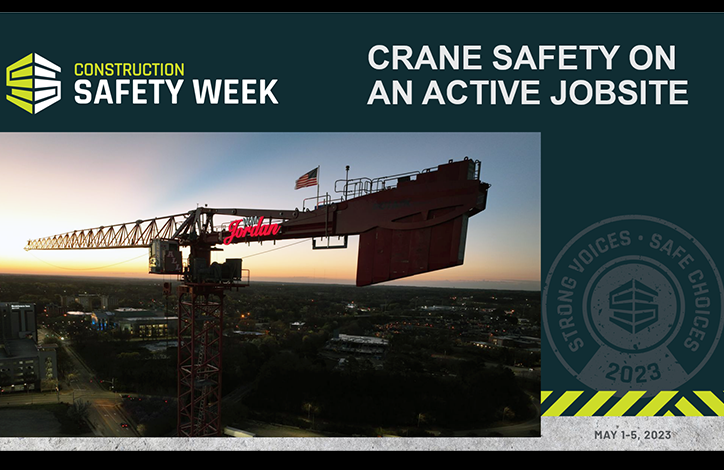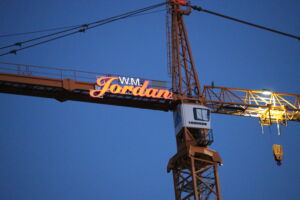
 Cranes are valuable tools that allow us to build and work on projects that we otherwise would not be able to construct. While a crane provides many advantages on a jobsite, it also comes with its own set of rules and safety precautions hat must be followed.
Cranes are valuable tools that allow us to build and work on projects that we otherwise would not be able to construct. While a crane provides many advantages on a jobsite, it also comes with its own set of rules and safety precautions hat must be followed.
For today’s Construction Safety Week spotlight, we spoke with WMJ Project Superintendent Jim Collins, who is currently utilizing a 285-foot tower crane on our 320 W. South Street project in Raleigh, North Carolina.
Jim let us know some of the extra precautions that are necessary to safely operate a crane on a W. M. Jordan jobsite.
- Inspection: Before using a crane, it should be inspected by a qualified person to ensure it is in good working order. The inspection should include a check of the controls, brakes, hoist ropes, and safety devices.
- Training: Only trained and qualified operators should be allowed to operate a crane. The operator should be familiar with the specific crane being used, as well as its load capacity and limitations.
- Site preparation: The construction site should be prepared to accommodate the crane, including leveling the ground and ensuring that there are no overhead obstructions.
- Load capacity: The crane should never be overloaded beyond its rated capacity. It’s important to ensure that the weight of the load is accurately calculated before attempting to lift it. Most cranes in use today have their own scale that can weigh their load and will not allow the crane to lift more than it is rated.

- Communication: A clear communication plan should be in place between the crane operator and other workers on the site. This can include hand signals, radios, or other communication devices.
- Wind and weather: Cranes should not be operated in high winds or severe weather conditions. The operator should be aware of weather forecasts and should shut down the crane if necessary. When not in use, cranes are designed to move with the wind, like a weathervane. Be sure to have air rights to any space the crane’s boom may go over, even if it is not in operation.
- Maintenance: Regular maintenance and inspections should be performed on the crane to ensure that it remains in good working order.
- Safety devices: Cranes should be equipped with safety devices, such as limit switches, load indicators, and emergency stop buttons. These devices can help prevent accidents and injuries. Additionally, tools like nylon pigtails are used when hoisting concrete buckets. In the off chance the crane is struck by lightning, the nylon will act as an insulator.
Continually being aware of your surroundings is one of the biggest factors in crane safety. Operators should have a lift plan in place before beginning work and constantly be on the lookout for any unforeseen obstacles the crane may face.
Safety is always paramount on any W. M. Jordan jobsite. We are thankful for our safety team, project teams and trade partners for all that they do to make sure everyone goes home at the end of the day.

